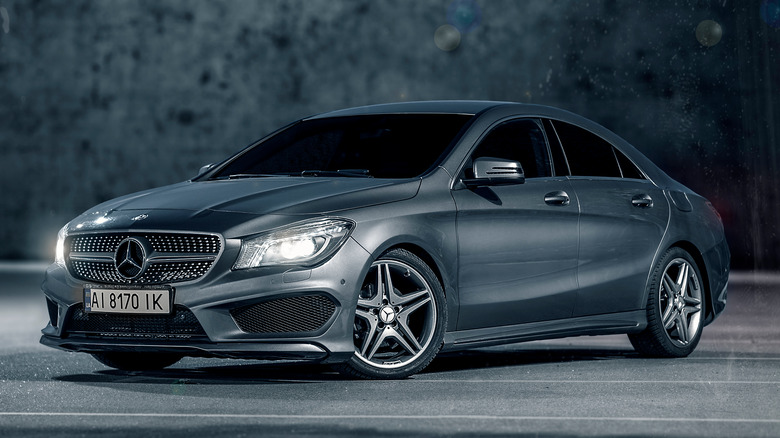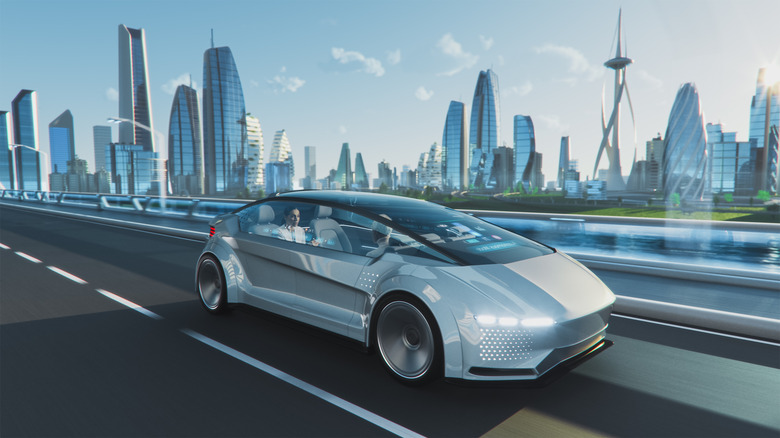How The New Mercedes-Benz Facility Could Impact The Brand's Future
The Internet of Things is a concept that's grown prevalent in our digital lives, connecting our smartphones and computers to every type of household appliance, from the kitchen fridge to the ceiling lights. Vehicle manufacturers are also making similar advancements in the automotive sector.
TechCrunch suggested in January 2021, for example, that an "Internet of Cars" would allow vehicles to use an array of sensors and networking hardware to send data directly to a roadside repair service or speak to one another in real-time, and the latter would theoretically assist drivers in navigating traffic congestion. Those are two potential benefits to such a technology becoming prolific on the road on a massive scale, and it seems like it's already beginning to materialize.
Reuters reported on April 8 that Mercedes-Benz has taken a major step forward in developing its own operating system, called MB.OS. The high-end car manufacturer has officially opened a brand-new software development center based in Sindelfingen, Germany, that cost more than $217.5 million to construct. Called the Electric Software Hub at the Mercedes Technology Center, the new facility is designed to make the operating system as secure and feature-rich as possible. The automaker should begin rolling out its proprietary MB.OS in new vehicles beginning in 2024, bringing the "Internet of Vehicles" several steps closer to mass adoption.
Mercedes-Benz is providing more than 3,000 new jobs
According to the Mercedes-Benz newsroom, the launch of the new Sindelfingen-based software development center coincides with the employment of 3,100 new employees worldwide, more than 1,100 of whom are employed at the new software development center itself. The diversity of technology involved in IoV means the car manufacturer isn't hiring exclusively for automotive engineering. New hires are working on various types of software that can be applied in future vehicle models, including everything from R&D to actually writing the code.
The new operating system will likely be an important, albeit adjacent, step for Mercedes-Benz toward its production of self-driving cars, which are reliant on the same sensors that make an Internet of Vehicles possible. On January 20, Mercedes-Benz announced a partnership with Luminar to provide lidar systems to its vehicles, which will allow future models to "see" how far other vehicles and objects are from a lidar-equipped Mercedes-Benz, up to a range of about 820 feet.
A Daimler Outlook released by Mercedes-Benz in February 2022 shows that the car manufacturer is still bracing for continued semiconductor shortages, which could impact the scale of its ability to produce new vehicles to meet demand. The company did note that, despite such headwinds, it is still going strong, projecting an adjusted return on sales for its Mercedes Cars division of at least 11.5%.
Self-driving cars are inherently tied to the Internet of Vehicles
Mercedes-Benz isn't the only car manufacturer working on its own proprietary operating system, and it isn't just car manufacturers that are trying to get in on the self-driving vehicle action. Similar developments are coming from chip manufacturers like NVIDIA, too. The highly popular GPU manufacturer is working on AI for vehicles, and it can be seen in action with its DRIVE Hyperion 8 self-driving car system.
Even Apple is supposedly working on securing its own spot in the self-driving car marketplace via its Project Titan. However, it has been heavily rumored that Project Titan has gone through a series of foundational shakeups, leaving potential buyers wondering when the Apple car may arrive. As such, there are no solid details on a self-driving Apple vehicle yet, but as more details arrive, we will report on them.
In related news, Mercedes-Benz recently launched its 2022 Mercedes AMG-SL and AMG EQS. We called the AMG-SL a "stately reinvention that doesn't stray too far from Mercedes' original winning formula," and we lauded the AMG EQS, a true-blue electric vehicle, for standing on its own against some of the highest-performance gas guzzlers operating in the $120k range.


